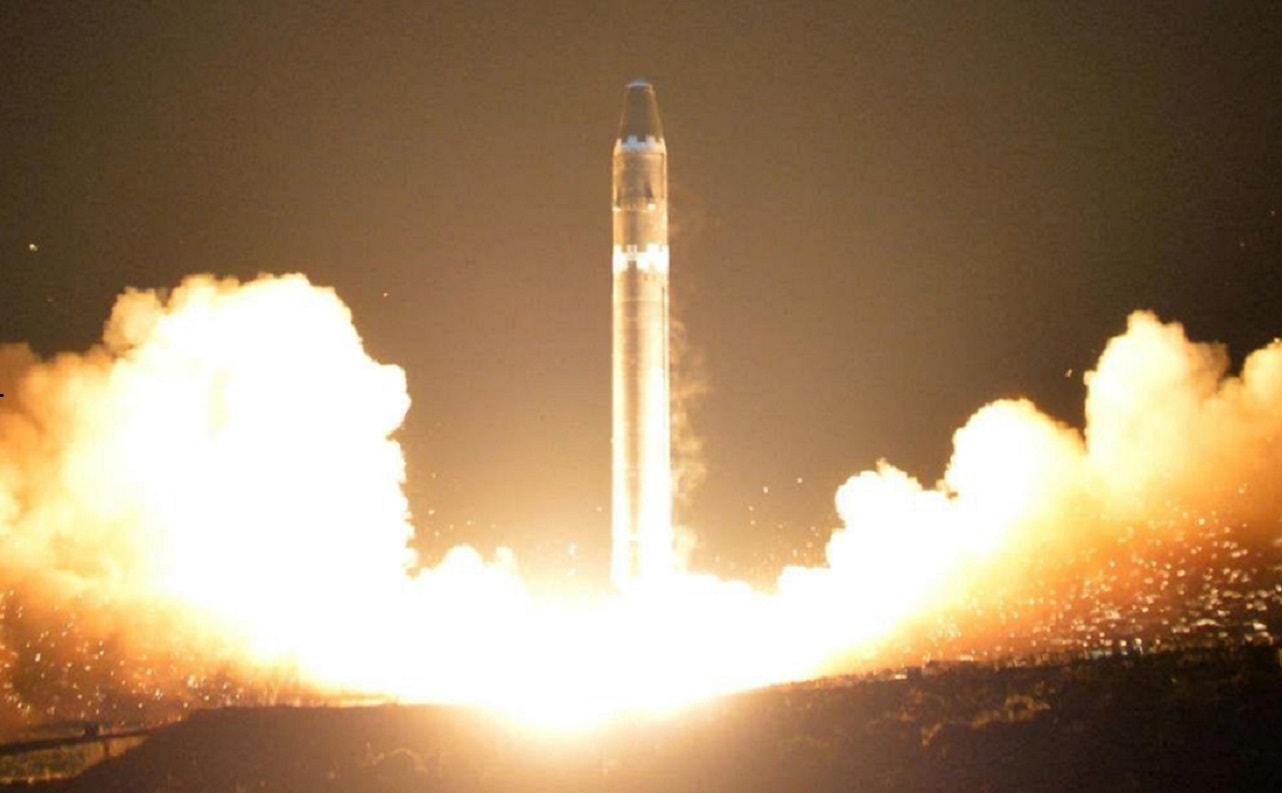Over the weekend of February 18th, North Korea conducted two more sets of important missile tests. On February 18th, North Korea launched what KCNA claimed was a Hwasong-15 (and early analysis tends to confirm that) on a lofted angle that if “leveled out” would have been sufficient to reach the continental United States.
The launch appeared to be successful, as a Japanese fighter pilot claims to have seen the re-entry vehicle that would carry a nuclear payload in an actual combat situation coming down on fire (which is normal) as it splashed into the ocean. This indicates the missile was able to successfully enter the earth’s atmosphere as it headed toward impact.
A couple of days later North Korea successfully launched projectiles it claimed were fired by a 600-millimeter multiple rocket launcher (MRL) from the country’s east coast. As this system launches guided weapons with the range of an SRBM, these are also classified as ballistic missiles. Both the Hwasong-15 and the 600-millimeter MRLs are systems the North Koreans claim are nuclear-capable.
It is key to note what we have learned from these latest launches. First, the North Koreans have successfully launched the Hwasong-15 several times. This speaks to the reliability of the system. Particularly for a system that would be used to launch a nuclear weapon, sustained reliability is important. The reliability of the highly publicized Hwasong-17 is a mixed bag at best – and thus we are also likely to see more tests of that system.
But it appears that the Hwasong-15, and any tweaks that the North Koreans continue to make to that system, will be a legitimate threat to nodes that Pyongyang plans to target. Some pundits have recently asked, “Why would they keep testing this system?” The reason is to make it as reliable as possible and to continue to advance its capabilities if necessary. As for the 600-millimeter MRL system that was tested, the same applies. New or recent systems simply must be tested when possible in order to maintain reliability and fix or improve on any glitches or design flaws that may occur.
While the points above are significant, the question still remains, what was the purpose of conducting these launches now? There are likely several reasons for this. One clear reason that this occurred now is that the North Koreans intended to demonstrate a “dual nuclear threat” to the ROK-US alliance. The Hwasong-15 presents a strategic threat designed to do one very important thing – target the United States. The 600-millimeter MRL system presents what Pyongyang has called a “tactical nuclear threat” to ROK and US forces on the Korean Peninsula. In other words, what the North Koreans mean by “tactical” is an on-Peninsula nuclear threat.
Another apparent reason for launching at least one of the systems (the Hwasong-15) now is to demonstrate the capabilities of this system to North Korea’s key proliferation partner, Iran.
The first stage of the Hwasong-15 appears to be the same or similar system to the 80-ton rocket booster that it has been confirmed the North Koreans have been developing for (and with) the Iranians. If the Iranians also want ICBM technology (and why would they not?) the Hwasong-15 would be the ideal system for them to acquire from the North Koreans. Since this is likely, continued demonstrations will be important as this would become an important system in Iran’s arsenal of ballistic missiles. It would also significantly exacerbate the Iranian military threat to Europe and of course, the United States.
The third reason for conducting these test launches now is an attempt by the North Koreans to split the ROK-US alliance. There is currently a debate on both sides of the Pacific about the role of extended deterrence within the alliance as it relates to the North Korean nuclear threat. As the threat continues to grow in capabilities, extended deterrence of course needs to be strengthened. But to generate debate and perhaps even talk of an arms race in East Asia only plays to North Korea’s hand. Any time there is disagreement within the alliance (whether perceived or real), this is to North Korea’s advantage. Pyongyang knows this, has always sought to use this to the advantage of the DPRK, and thus, when non-violent provocations such as those that occurred over the weekend of February 18th are noted, North Korea’s political reasons for carrying them out must always come under consideration.
Fortunately, there are various ways to counter North Korea’s recent actions and the ROK-US alliance is doing many of them. For example, Extended Deterrence can and is likely to be strengthened in ways that will further contribute to the defense of the ROK.
In addition, joint/combined exercises simulating nuclear scenarios can (and are) likely to be conducted regularly as part of training with ROK and American forces. One thing that South Korea has not done is join the US-led BMD system. This is a mistake. Seoul’s “Kill-Chain” system may be (or may not be) effective in taking out North Korea’s nuclear facilities and the missiles that would carry them (or at least some of them). But it does not protect one South Korean civilian.
Ballistic Missile Defense is vital for a nation-state that is literally more directly threatened by missiles and rockets than any other place on earth. While it is expensive, the ROK government needs to seriously consider expanding its own BMD, joining the US-led system, and significantly increasing the training and exercises that adding these capabilities will make necessary. To do so will exponentially increase the safety of the Korean people during war.
Dr. Bruce E. Bechtol, Jr. (Ph.D. Union Institute), is an award-winning professor of political science at Angelo State University and a retired Marine. The author of five books on North Korea, he is also the current President of the International Council on Korean Studies. He specializes in North Korean military and counter-proliferation issues. Bechtol is a 19FortyFive contributing editor.

